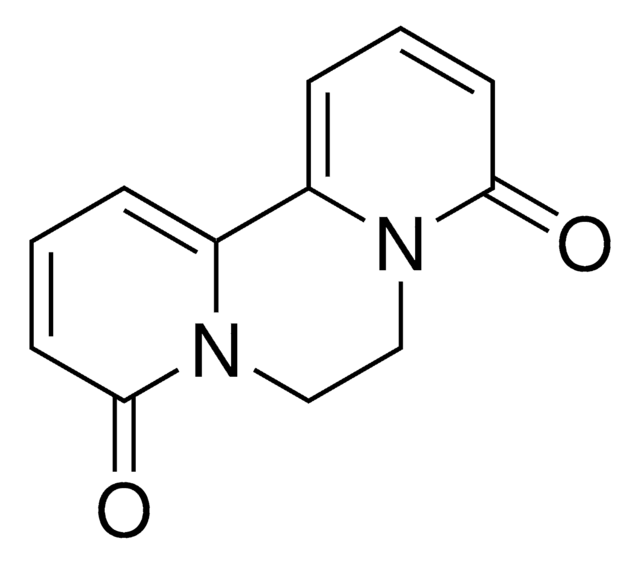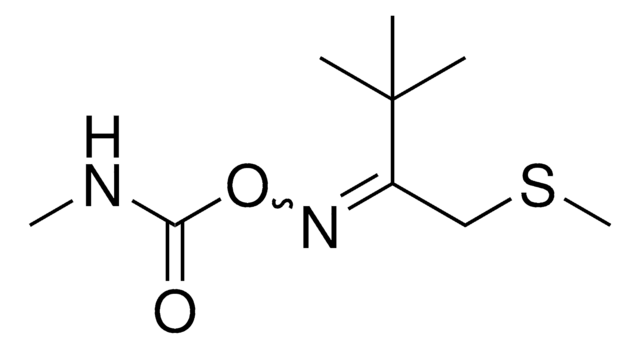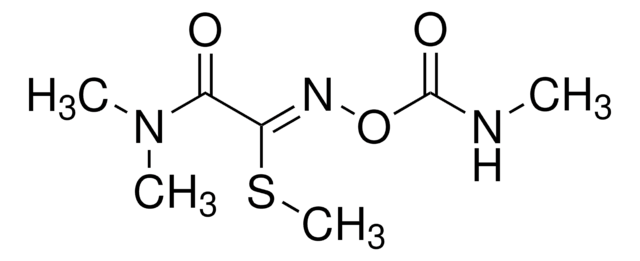おすすめの製品
詳細
This certified reference material (CRM) is produced and certified in accordance with ISO/IEC 17025 and ISO 17034. This CRM is traceable to primary material from an NMI, e.g. NIST or NMIJ.
Certified content by quantitative NMR incl. uncertainty and expiry date are given on the certificate.
Download your certificate at: http://www.sigma-aldrich.com
Diquat metabolite TOPPS is a common degradation product of diquat. Diquat is a nonselective, defoliant, preharvest, and non-residual bipyridyl herbicide and crop desiccant, normally used as the dibromide salt, to control broad-leaved weeds and grasses. Its activity is based on the liberation of the superoxide anion radical and, subsequently, hydrogen peroxide, leading to tissue destruction by oxidative stress. The herbicidal activity of diquat is more pronounced in daylight, aerobic conditions, high humidity, and temperature.
As per Regulation (EC) No 1107/2009, repealing the directive 91/414/ECC, diquat is not approved for use in the European Union (EU). The maximum residue limit (MRL) for diquat presence in the crops varies between 0.01 mg/kg in most of the commodities to 5 mg/kg for linseed in accordance with Regulation (EU) 2016/1002.
Certified content by quantitative NMR incl. uncertainty and expiry date are given on the certificate.
Download your certificate at: http://www.sigma-aldrich.com
Diquat metabolite TOPPS is a common degradation product of diquat. Diquat is a nonselective, defoliant, preharvest, and non-residual bipyridyl herbicide and crop desiccant, normally used as the dibromide salt, to control broad-leaved weeds and grasses. Its activity is based on the liberation of the superoxide anion radical and, subsequently, hydrogen peroxide, leading to tissue destruction by oxidative stress. The herbicidal activity of diquat is more pronounced in daylight, aerobic conditions, high humidity, and temperature.
As per Regulation (EC) No 1107/2009, repealing the directive 91/414/ECC, diquat is not approved for use in the European Union (EU). The maximum residue limit (MRL) for diquat presence in the crops varies between 0.01 mg/kg in most of the commodities to 5 mg/kg for linseed in accordance with Regulation (EU) 2016/1002.
アプリケーション
The certified reference material (CRM) is intended to be used as a calibrant for chromatography and other analytical techniques.
おすすめ製品
Find a digital Reference Material for this product available on our online platform ChemisTwin® for NMR. You can use this digital equivalent on ChemisTwin® for your sample identity confirmation and compound quantification (with digital external standard). An NMR spectrum of this substance can be viewed and an online comparison against your sample can be performed with a few mouseclicks. Learn more here and start your free trial.
法的情報
TraceCERT is a registered trademark of Merck KGaA, Darmstadt, Germany
シグナルワード
Danger
危険有害性の分類
Acute Tox. 2 Inhalation - Acute Tox. 3 Dermal - Acute Tox. 3 Oral - Aquatic Acute 1 - Aquatic Chronic 1 - Eye Irrit. 2 - Skin Irrit. 2 - Skin Sens. 1 - STOT RE 1 Oral - STOT SE 3
ターゲットの組織
Respiratory system
保管分類コード
6.1A - Combustible acute toxic Cat. 1 and 2 / very toxic hazardous materials
WGK
WGK 3
引火点(°F)
Not applicable
引火点(℃)
Not applicable
適用法令
試験研究用途を考慮した関連法令を主に挙げております。化学物質以外については、一部の情報のみ提供しています。 製品を安全かつ合法的に使用することは、使用者の義務です。最新情報により修正される場合があります。WEBの反映には時間を要することがあるため、適宜SDSをご参照ください。
Jan Code
CRM80884-BULK:
CRM80884-10MG:
最新バージョンのいずれかを選択してください:
ライフサイエンス、有機合成、材料科学、クロマトグラフィー、分析など、あらゆる分野の研究に経験のあるメンバーがおります。.
製品に関するお問い合わせはこちら(テクニカルサービス)









